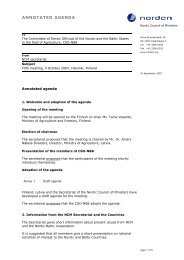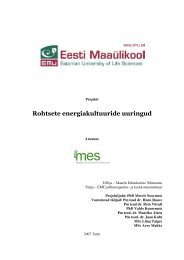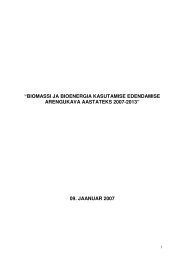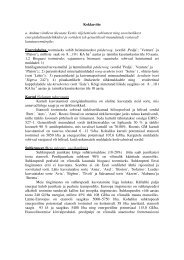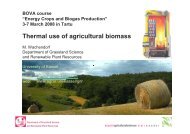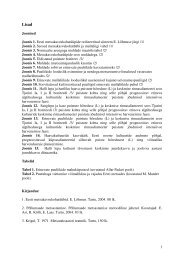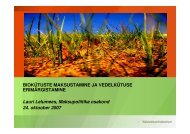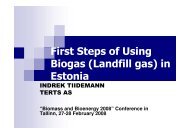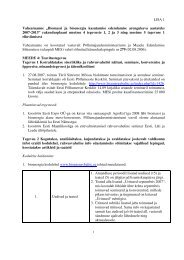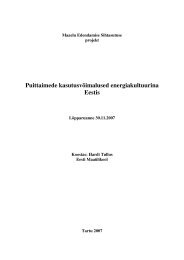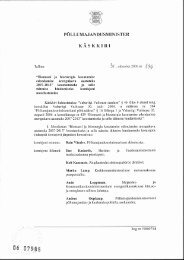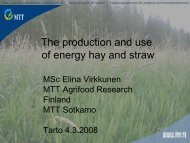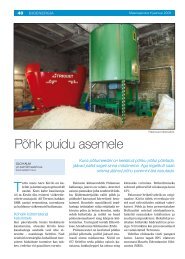Põllumajandusministeeriumi ja Maaelu ... - bioenergybaltic
Põllumajandusministeeriumi ja Maaelu ... - bioenergybaltic
Põllumajandusministeeriumi ja Maaelu ... - bioenergybaltic
You also want an ePaper? Increase the reach of your titles
YUMPU automatically turns print PDFs into web optimized ePapers that Google loves.
problem-free only in fluidized bed boilers while the share of unknown biomass-based fuel<br />
should not exceed 10% of the total fuel amount. In conditions of Estonia it would mean<br />
agreements with the biomass-based CHP plants (Väo and Tartu) which are under<br />
comnstruction or being designed and where the fluidized bed boilers have sufficient capacity<br />
for the safe burning of small biomass batches. However, this kind of work may require also<br />
building either of an additional fuel feeding unit, or in a less complicated case mixing small<br />
amounts of additional fuel with the main fuel would be sufficient.<br />
Up to now nobody has been engaged in designing special (small) boilers suitable for burning<br />
herbaceous biomass either in Estonia or in other countries, because the amounts of herbaceous<br />
biomass are small and the development would not be economically feasible. Thus we must<br />
look for the most appropriate existing equipment for burning herbaceous biomass and give<br />
preliminary recommendations for solving the possible problems related to the combustion<br />
technology. As a rule, the most uncomfortable problem is the low melting temperature of<br />
herbaceous biomass ash that may cause the ash becoming sticky and clogging the grate. The<br />
stoker burner for pellet burning could be tested for checking the combustion conditions of<br />
such fuels when the burner heads are cleaned after short intervals or mechanical ash removal<br />
is applied. High Na and K content in the ash refers to the low ash melting temperature, but due<br />
to the co-influence of many other components, this relationship cannot be pointed out. The<br />
dangerously low melting temperature of ashes may occur in case of some fuel blends in spite<br />
of the fact that the ash melting temperatures of both fuels are significantly higher.<br />
Building of a special unit for upgrading various biomass types is not reasonable considering<br />
the limited possibilities of Estonian market. It would be reasonable to select the equipment by<br />
pilot production and based on the gained experience it may be expedient to adapt the press<br />
slightly for a certain biomass type. Before starting wide-scale upgrading of herbaceous<br />
biomass, the conditions necessary for burning the output must be checked and decision about<br />
the expediency of making the products taken.<br />
In Estonia the waste combustion is controlled with the regulation no 66 of the Minister of<br />
Environment from June 4, 2004 “Requirements for Building, Use and Closing of Waste<br />
Incineration Plant and Co-incineration Plant” (RTL, 21.06.2004, 83, 1316). The requirements<br />
of the regulation are valid both for big and small incineration plants with over 50 t of waste a<br />
year.<br />
In the incineration plant of non-hazardous waste such a level of waste should be reached that<br />
the total content of organic carbon (TOC) in the slag and bottom ash formed by incineration<br />
remains below 3% or their heat loss is below 5% from the dry matter of the substance. The<br />
temperature of flue gas derived from waste incineration must rise at least to 850 o C after the<br />
last combustion air injection and remain at this temperature at least for 2 seconds. The content<br />
of pollution components in the wastewater from cleaning the waste incineration flue gases<br />
must not exceed the limit values of pollutants specified by the Waste Incineration Regulations.<br />
A waste incineration plant must be equipped with a collection tank of sufficient volume for the<br />
water from rainfall leaks and firefighting. At the wastewater outlet the pH, temperature and<br />
rate of flow must be regularly measured. Once a day the content of floating matter in the<br />
averaged sample proportional to the flow rate must be determined. The Hg, Cd, Tl, As,Pb, Cr,<br />
Cu, Ni and Zn content must be established in the averaged sample proportional to the daily<br />
flow rate at least once a month and the dioxyne and furane content must be measured at least<br />
once in three months. The method of conducting more exact measurements is specified in the<br />
Waste Incineration Regulations.<br />
The technologies suitable for waste incineration are expensive due to strict environmental<br />
requirements and problems related to the incineration techniques. Therefore, construction of<br />
only big incinerators for over 200,000 tons of waste a year is considered economically<br />
feasible. It is not expedient to build more than two or utmost three waste incineration plants in<br />
101



